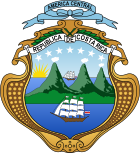Liberalism in Costa Rica
 |
|---|
|
|
| Part of a series on |
| Liberalism |
|---|
 |
Liberalism in
Early history
The first victory of liberalism in the country was during the country's first civil war, the Ochomogo War in 1823 when the liberal-dominated cities of San José and Alajuela fought against the conservative-dominated cities of Heredia and Cartago due to the former's wish to split from the First Mexican Empire and becoming a Republic, whilst the Heredian and Cartaginese creole aristocracy favored to remain in the Empire as a way to protect their interests, and also as a clash of economic visions between the more liberal bourgeoisie and the agrarian aristocracy.[1] The war between the Republicans and Imperialists was won by the Republicans and the capital was moved from Cartago to San José.
The Liberal State
Liberals will rule the country since its independence from Mexico, as almost all Presidents were liberals between 1825 and 1940 with only a few exceptions, and even during the country's membership in the
The amount of important liberals in Costa Rica's history would be too large to list, but to mention a few this may include presidents like
This period of dominance of the liberal ideas is known as the Liberal State of Costa Rica and encompassed between 1870 and 1940. Liberals of these times were mostly
Due to the hegemony of the liberals, all de facto governments and internal factional conflicts were between them.
Nevertheless, the exhaustion of the liberal model was most evident not by the actions of the conservatives but by the birth of more left-wing political movements.
This may have helped the triumph of
Second Republic
During the war, an alliance of liberals and conservatives led by
But the
The Unity Coalition was the alliance of four parties: Christian Democratic Party, Republican Calderonista Party (led by Calderon's son), the People's Union (led by Trejos) and the more left-wing Democratic Renovation (led by Carazo).
This changed with the foundation of the
However, despite having important roles in both the
Other newly form liberal parties were created more recently including the
References
- ^ a b c d e f g h i González Chaves, Daniel (2014). "Los partidos políticos en Costa Rica: un acercamiento histórico". Revista Asociación para el Fomento de los Estudios Históricos en Centroamérica. Archived from the original on 2015-06-20.
- ^ a b "Costa Rica. El golpe de Tomás Guardia (1870) y la etapa liberal (1871- 1940)". EUMED. Retrieved 22 December 2018.
- ^ "Fundación de la república". Costa Rica web. Retrieved 22 December 2018.
- ^ "Fundación de la República". Archivo nacional. Retrieved 22 December 2018.
- ^ "¿Cómo se proclamó Costa Rica como República?". Museo de Costa Rica. Retrieved 22 December 2018.
- ^ ISBN 9789977678672.
- ^ Salazar, Jorge Mario. "Estado liberal y luchas sociales en Costa Rica: 1870-1920". Revista de Ciencias Sociales. Archived from the original on 15 December 2013. Retrieved 22 December 2018.
- ^ Muñoz, Eduardo (2009). "Investigación revela detalles del último cacique". Semanario Universidad. Retrieved 23 December 2018.
- ^ ISBN 9789968313605.
- ^ "Costa Rica". San José University. Archived from the original on 13 March 2016. Retrieved 27 March 2016.
- ^ "¿Ha sido consistente Guevara frente al matrimonio gay?". El Financiero. Retrieved 2018-12-23.[dead link]
- ^ "Liberal and conservative ideologies clashed in first official presidential debate", Inside Costa Rica, 6 January 2014
- ^ Molina, Tabatha. "Libertarian Party VP in Costa Rica Faces 16 Years for Fraud". Panama Post. Archived from the original on 7 April 2016. Retrieved 27 March 2016.
- ^ Madrigal, Rebeca. "Libertarian Movement will get 500 million colones from Promérica Bank in order to fund their last campaign in the days before the election". La Nación. Retrieved 26 January 2018.
- ISBN 9781475812282. Retrieved 27 March 2016.
- ISBN 9781475818710. Retrieved 27 March 2016.
